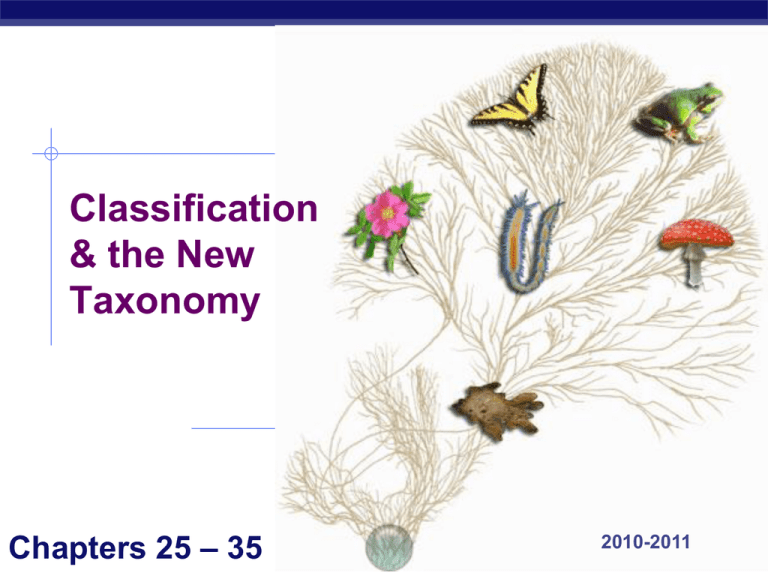Prokaryotes Notes
advertisement

Classification & the New Taxonomy AP Biology Chapters 25 – 35 2010-2011 Solar System Finding commonality in variety Organisms classified from most general group, domain, down to most specific, species domain, kingdom, phylum, class, order, family, genus, species Earth No. America U. S. N. Y. Putnam Valley Peekskill Hollow Rd use the mnemonic! AP Biology HS Eukaryote Classification Old 5 Kingdom system Prokaryote Monera, Protists, Plants, Fungi, Animals New 3 system reflects a greater understanding of evolution & molecular evidence _______________________ _______________________ _______________________ AP Biology ___________________ ___________________ ___________________ ___________________ Archaebacteria & Bacteria Kingdom ________________ Kingdom ____________ AP Biology Kingdom ________________ Kingdom ________________ Kingdom ____________ Kingdom ____________ The Evolutionary Perspective AP Biology Kingdoms Fungi Animalia absorptive nutrition ingestive nutrition Plantae autotrophs heterotrophs Protista uni- to multicellular Eubacteria multicellular Archaebacteria prokaryotes AP Biology Single-celled ancestor eukaryotes Prokaryotes Domain Bacteria Domain Archaebacteria Domain Bacteria AP Biology Domain Archaea Domain Eukarya 2007-2008 Common ancestor Bacteria live EVERYWHERE! Bacteria live in all ecosystems on plants & animals in plants & animals in the soil in depths of the oceans Microbes always in extreme cold find a way to make a living! in extreme hot in extreme salt on the living on the dead AP Biology Bacterial diversity rods and spheres and spirals… Oh My! AP Biology eukaryote cell Prokaryote Structure Unicellular prokaryote cell bacilli, cocci, spirilli Size 1/10 size of eukaryote cell 1 micron (1um) Internal structure _________________________________ _____________________________ _____________________________ AP Biology _________________________________ not wrapped around proteins Prokaryote vs. Eukaryote Chromosome Prokaryote Eukaryote double helix AP Biology mitochondria Variations in Cell Interior cyanobacterium (photosythetic) bacterium chloroplast AP Biology aerobic bacterium Prokaryote Cell Wall Structure Gram-positive bacteria peptide side chains cell wall peptidoglycan plasma membrane That’s important for your doctor to know! protein peptidoglycan = polysaccharides + amino acid chains lipopolysaccharides = lipids + polysaccharides Gram-negative bacteria cell wall outer membrane of lipopolysaccharides outer membrane peptidoglycan AP Biology plasma membrane Prokaryotic metabolism How do bacteria acquire their energy & nutrients? ___________________ photosynthetic bacteria ___________________ oxidize inorganic compounds nitrogen, sulfur, hydrogen… ___________________ live on plant & animal matter decomposers & pathogens AP Biology Genetic variation in bacteria Mutations bacteria can reproduce every 20 minutes ______________________ error rate in copying DNA 1 in every 200 bacteria has a mutation you have billions of E. coli in your gut! lots of mutation potential! Genetic recombination bacteria swap genes ____________________ small supplemental circles of DNA ____________________ AP Biology conjugation direct transfer of DNA Bacteria as pathogens Disease-causing microbes ___________________ wilts, fruit rot, blights ____________________ tooth decay, ulcers anthrax, botulism plague, leprosy, “flesh-eating” disease STDs: gonorrhea, chlamydia typhoid, cholera TB, pneumonia lyme disease AP Biology Bacteria as beneficial (& necessary) Life on Earth is dependent on bacteria ___________________________ recycling of nutrients from dead to living ___________________________ only organisms that can fix N from atmosphere needed for synthesis of proteins & nucleic acids plant root nodules ___________________________ digest cellulose for herbivores cellulase enzyme produce vitamins K & B12 for humans _________________________ from yogurt to insulin AP Biology Domain Archae Live in extreme environments Methanogens: Halophiles Thermophiles AP Biology Got any Questions?? Ask da’ Bacterial Boss! AP Biology 2010-2011



